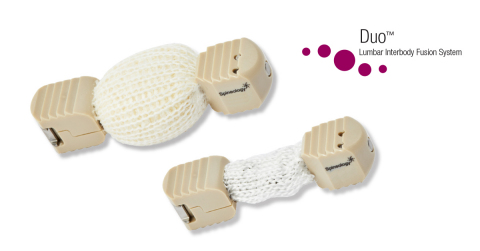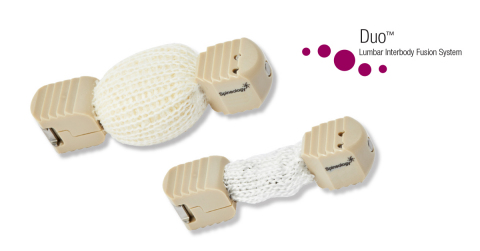ST. PAUL, Minn.--(BUSINESS WIRE)--Spineology Inc., an innovator in anatomy-conserving spine surgery, is excited to announce that two laboratory studies relating to the Spineology Duo™ Lumbar Interbody Fusion System were presented at the recent annual meeting of the International Society for the Advancement of Spine Surgery (ISASS) in Toronto, Canada.
The Duo implant is the first to combine PEEK, titanium, and graft containment mesh elements. The unique hybrid design includes lateral PEEK supports integrated with an expandable porous mesh that serves to contain bone graft. The Duo implant, filled with bone graft after it is placed in the disc space, provides a large, endplate-conforming graft pack up to 30mm in width, to help maintain spinal alignment and support fusion. Due to the unique design of the implant, the Duo System requires minimal retraction for placement of the implant which may reduce direct and indirect injury to the neural elements and potentially decrease the postoperative complications commonly associated with the lateral decubitus transpsoas approach.
Pierce Nunley, M.D., Director of The Spine Institute of Louisiana and Lisa Ferrara, Ph.D., President of OrthoKinetic Technologies LLC, co-authored a study titled “Size Matters: A Novel Interbody Fusion Cage Design Increases Contact Area for Bone Exchange and Graft Incorporation.” A unique test methodology using pressure-sensitive contact film demonstrates that the Duo device design facilitates load-sharing contact between bone graft and endplates to support graft incorporation during fusion healing. Pressure profiles were generated during testing for the Duo implants and for monolithic PEEK interbody cages (Spineology Rampart™ L). The results showed that the expandable porous mesh of the Duo implant allows for direct contact between bone graft and the viscoelastic vertebral endplates, improving the endplate and graft interface mechanics.
Barbara Boyan, Ph.D., Dean of Engineering at Virginia Commonwealth University, presented the results of an in vitro cell culture model used to assess whether the Duo implant’s polyethylene terephthalate (PET) mesh would have an impact on migration of osteoprogenitor cells from vertebral endplates onto bone graft in interbody fusion, and to assess the biological response of these cells to the bone graft. The study, titled “Effect of PET Mesh on Mesenchymal Stem Cell Response to Bone Autograft”, indicated that the presence of the porous mesh does not negatively impact the ability of osteoblast lineage cells to attach to bone particles, nor does it impede the cells’ ability to proliferate or differentiate along an osteoblastic pathway.
“The graft containment mesh is a key component of the Duo implant design,” said John Booth, CEO, Spineology Inc. “Not only does it allow for the implant to be placed with minimal retraction and expand in width up to 30mm once filled in situ, it also provides improved graft loading properties compared to traditional monolithic PEEK cages and has a positive impact on osteoprogenitor cell activity, as demonstrated by the studies presented at ISASS.”
Spineology is currently conducting a prospective post-market lateral interbody fusion study with the Duo System. The primary study objectives are to gather data related to the new on-set of thigh symptoms, quality of life measures, and fusion outcomes. The company believes the minimal amount of retraction required to place the Duo implant will have a positive impact on post-operative thigh symptoms.
About Spineology Inc.
Spineology Inc. provides innovative,
anatomy-conserving spinal technologies for surgeons and their patients.
Spineology surgical techniques conserve spinal bone, ligament and muscle
tissue. Spineology is committed to increasing procedural efficiency,
reducing surgical morbidity and accelerating patient recovery. Learn
more at spineology.com.




